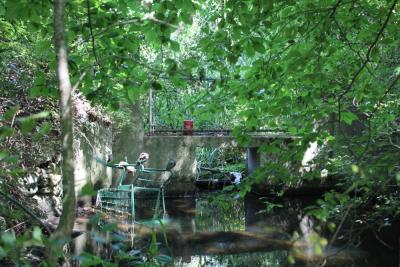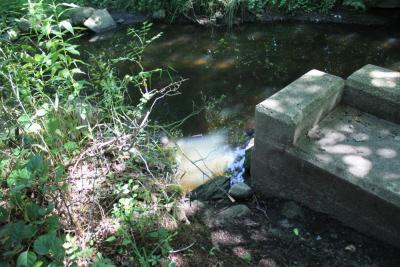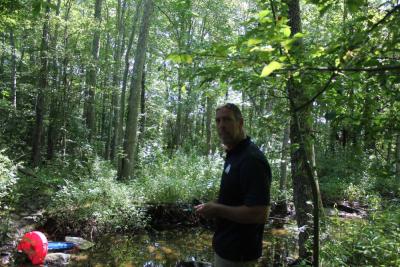‘Protect what you love’ Buttonwood Brook needs help according to local expert
Buttonwood Brook runs through both Dartmouth and New Bedford. But because of climate change and some concerning locations for development, that run has become a sprint.
That’s according to Daniel Goulart, who manages the Buttonwood to Bay Project for the Buzzards Bay Coalition.
The increasing speed of water flow in the brook comes from increasingly heavy rainfall annually. Since storm drains connect directly to the brook, there is no time for the water to filter into the ground.
Heavy rain takes pollutants and sediment from the roads down the brook and dumps it into Apponagansett Bay.
When including the brook’s branching tributaries, there are nine miles of running water that lead into the bay.
The brook has already begun flooding some properties during heavy rain, said Goulart.
He explained that the flooding will worsen if nothing is done to help the brook. The flooding will start where the brook follows Route 140 and will become a problem further down over time.
There are many homes in both Dartmouth and New Bedford that abut the water way, and that are at increasing risk of flooding as climate change continues to produce more frequent and more intense rainstorms.
Goulart says he has spoken with many of those homeowners and they are worried about their properties.
Flooding is not the only problem with the brook. It is also the quality of the water, which is visibly dirty and smells like a sewer at various sections, Goulart pointed out at Buttonwood Park and further down the brook.
“Apponagansett Bay has consistently been ranked in the bottom 10% of all bays and harbors in Buzzards Bay and has a Bay Index Score of 31 out of 100,” Goulart said. “For reference inner Clarks Cove has a score of 66 and the inner New Bedford Harbor has a score of 45.”
There are various solutions to the problem, Goulart said. For homeowners, it can be as simple as reducing how many chemicals are used in their yards, collecting rainwater or installing a rain garden to reduce runoff.
At a town level, Goulart says similar green infrastructure implementation is a clear solution.
“Green infrastructure and nature based solutions allow us to mimic natural processes in developed areas by creating space for water to soak back into the ground and feed groundwater and using native plants to absorb pollutants like nitrogen and phosphorus.”
An example of green infrastructure is adding water passages on sidewalks so all the rain water on a street is not funneled through a storm drain directly into the brook.
At the surface level, letting the water soak through the ground into the brook will have two benefits. The first is, slowing the rate that the water enters the brook. This will result in less erosion in the brook and will decrease the risk of flood because the ground has more time to absorb the water.
The second benefit is reducing the amount of pollution that can make it through the brook into the bay, because it is able to filter out through the ground.
Another solution is to protect what Goulart calls “pocket forests.” These small breaks from urbanization on the brook’s trip south.
“These same areas are the last remaining buffer for extreme weather events, they absorb flood water and help to regulate extreme temperatures,” he said. “They are critical to our ability to adapt to climate change and also play a significant role in filtering brook water before it gets to Apponagansett Bay.”
To do this, groups like the Buzzards Bay Coalition and the Dartmouth Natural Resource Trust buy forest and wetlands to protect them from development. This allows the waterway to have a floodplain in some areas to slow and clean the water. In other words, the “pocket forests” would protect homes from flooding and Apponagansett Bay from pollution.
Goulart also believes part of the solution is making the brook more accessible by creating a trail that follows it.
“[The brook is] tucked away in these beautiful pocket forests that are difficult to access and largely overlooked,” Goulart said.
He believes that welcoming people to see the brook within pocket forests will encourage its preservation.
“Yvonne Choinard, the founder of Patagonia, said ‘you only protect what you love,’" Goulart said.

















